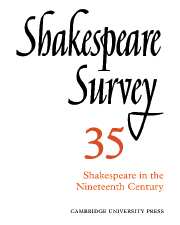Book contents
- Frontmatter
- Before the Shakespeare Revolution: Developments in the Study of Nineteenth-Century Shakespearian Production
- The Meininger Company and English Shakespeare
- Shakespeare at the Burgtheater: From Heinrich Anschütz to Josef Kainz
- Shakespeare on the Melbourne Stage, 1843-61
- Shakespeare in Hazlitt’s Theatre Criticism
- Characterization of the Four Young Lovers in A Midsummer Night’s Dream
- Queenly Shadows: On Mediation in Two Comedies
- Language, Theme, and Character in Twelfth Night
- The Art of the Comic Duologue in Three Plays by Shakespeare
- ‘Spanish’ Othello: The Making of Shakespeare’s Moor
- Ferdinand and Miranda at Chess
- Shakespeare’s Latin Citations: The Editorial Problem
- The Theatre at Christ Church, Oxford, in 1605
- Interpretations of Shakespearian Comedy, 1981
- The Year's Contributions to Shakespearian Study 1 Critical Studies
- 2 Shakespeare’s Life, Times and Stage
- 3 Textual Studies
- Index
- Plate Section
The Art of the Comic Duologue in Three Plays by Shakespeare
Published online by Cambridge University Press: 28 March 2007
- Frontmatter
- Before the Shakespeare Revolution: Developments in the Study of Nineteenth-Century Shakespearian Production
- The Meininger Company and English Shakespeare
- Shakespeare at the Burgtheater: From Heinrich Anschütz to Josef Kainz
- Shakespeare on the Melbourne Stage, 1843-61
- Shakespeare in Hazlitt’s Theatre Criticism
- Characterization of the Four Young Lovers in A Midsummer Night’s Dream
- Queenly Shadows: On Mediation in Two Comedies
- Language, Theme, and Character in Twelfth Night
- The Art of the Comic Duologue in Three Plays by Shakespeare
- ‘Spanish’ Othello: The Making of Shakespeare’s Moor
- Ferdinand and Miranda at Chess
- Shakespeare’s Latin Citations: The Editorial Problem
- The Theatre at Christ Church, Oxford, in 1605
- Interpretations of Shakespearian Comedy, 1981
- The Year's Contributions to Shakespearian Study 1 Critical Studies
- 2 Shakespeare’s Life, Times and Stage
- 3 Textual Studies
- Index
- Plate Section
Summary
Since Francis Douce’s pioneering study of the ‘clowns and fools’ of the Elizabethan stage, a good deal of scholarly scrutiny and critical interpretation has been directed towards Shakespeare’s use of his inheritance from popular drama in general and from traditions of fooling in particular. But compared with the detailed studies that have been devoted to the serious dramatic functions that Shakespeare developed for the solo-turn exemplified by Launce’s monologues in The Two Gentlemen of Verona and the porter scene in Macbeth, that other familiar routine of popular comedy–the double-act–has been somewhat neglected. William Willeford traces the origins of the ‘knockabout fool pair’ to the interplay between the Devil and the Vice in the Tudor moralities; and Austin Gray identifies the comic personalities of the actors Will Kemp and Dick Cowley behind the long line of Shakespearian double-acts, from Launce and Speed to the grave-diggers in Hamlet, offering this account of the relationship between the stooge and the lead comedian:
This old fellow is a mere shadow to his wiser gossip. It is his business to ask simple-minded questions or to listen in simple-minded wonder to the dogmatic wisdom of his friend. In short, his main duty is to be the cause that wit and comicality express themselves through the mouth of his friend.
- Type
- Chapter
- Information
- Shakespeare Survey , pp. 87 - 100Publisher: Cambridge University PressPrint publication year: 1982
- 1
- Cited by



